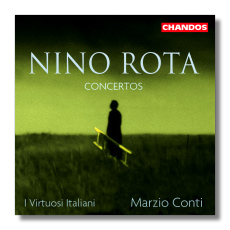
The Internet's Premier Classical Music Source
Related Links
- Rota Reviews
- Latest Reviews
- More Reviews
-
By Composer
-
Collections
DVD & Blu-ray
Books
Concert Reviews
Articles/Interviews
Software
Audio
Search Amazon
Recommended Links
Site News
 CD Review
CD Review
Nino Rota

Concertos
- Harp Concerto
- Bassoon Concerto
- Castel del Monte
- Trombone Concerto
Luisa Prandina, harp
Paolo Carlini, bassoon
Guido Corti, horn
Andrea Conti, trombone
I Virtuosi Italiani/Marzio Conti
Chandos CHAN9954 DDD 61:52
Interest in Nino Rota's concert music continues to accelerate. The composer's unwillingness to emulate the musical experimentation rife in the mid-twentieth century made it more difficult for him to be taken seriously in academic circles, a malady that is rapidly fading. (Rota, of course, was most famous for his film scores, notably for the films of Federico Fellini, including La Strada and La Dolce Vita.)
This CD contains three première recordings; only the Trombone Concerto has seen a prior recording. These works were written over a period of three decades; the Harp Concerto dates from1947, and the Bassoon Concerto was completed in 1977, two years before Rota's death. From earliest to latest, they show little stylistic evolution, but Rota was one of those composers who knew who he was early on, and he remained comfortable with his identity throughout his career. His music's characteristics include sanity, charm, conservatism, humor, and a dedication to leaving the listener with a good taste in his ears. Oh yes: they're as tonal as tonal can be. Rota was not a film composer with concert-hall pretensions; if anything, he was the opposite. His excellent academic training – with Casella and Pizzetti, among others – made it nearly impossible for him to commit errors of technique. He was a skilled craftsman who seemed to want nothing more than to allow musicians and their audiences enjoy themselves. Who can fault him for that?
The Harp Concerto sounds agreeably archaic. Rota has smoothed away the rough edges, yet there's enough of interest in the music's subtly archaic writing to keep listeners intrigued. The Bassoon Concerto is not only gently comical – as one would expect a bassoon concerto to be – it's also sweet and lyrical, gentlemanly in its good natured bumbling. Castel del Monte, a "Ballad for Orchestra" from 1975, features ebullient and heroic writing for the soloist as befits the titular location – an old Italian castle. Again, Rota tends to tip his hat toward the Romantic past, but stodginess is avoided through angular modernistic gestures. Finally, the brief Trombone Concerto (1966) puts the soloist through his paces with a series of virtuoso challenges. It takes the lungs of a knight in armor to meet these challenges, and it takes a knight's archaic soul to appreciate Rota's heroic conservatism fully.
I Virtuosi Italiani have participated in two previous Rota recordings for Chandos (CHAN 9681 and CHAN9892), and they attack their task with skill and sympathy. The soloists are excellent too, with Andrea Conti (any relation to the conductor?) earning special honors in the Trombone Concerto. Chandos' engineering is natural, and complementary to both the musicians and the music.
Copyright © 2002, Raymond Tuttle


















